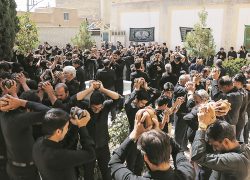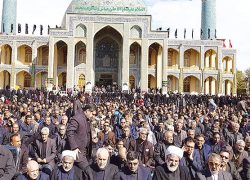Archive Muharram

The Ritual of Sang-Zani in Shahreza:
Grieving Stones
The Bani Assad Congregation, known as the Sang-Zan-ha, is a well-established religious group in Shahreza, which performs its unique ritual in this city from one day before Tasu’a (Muharram 9) until the 13th day of Muharram.

The Mourning Ritual on Safar 28th in Badroud:
A Social and Religious Ritual
Exactly 48 days after the anniversary of the tragic events of Ashura, a great ritual known as the 48th ritual is performed in Badroud, attended by a large population of mourners coming from different parts of the country.

The Mourning Ritual of Tekiyeh in Nikabad:
The Taste of Muharram Observances
The ceremony of Tekiyeh in this city is 200 years old and is held annually for 60 nights during the two months of Muharram and Safar, in more than 20 congregation halls presenting 1500 sessions.

Kotal Ceremony of Nushabad:
Muharram’s Children
Kotal is one of the most magnificent Ashura rituals. It is filled with secrets, symbols and signs. In some sources, kotal is defined as an embellished horse.

Saqaei of Nushabad:
Collective Recitation of Elegies
Saqaei is to lament the sufferings experienced by the family of Prophet Muhammad, in particular Imam Husayn and his companions, in the form of a collective and coordinated monody.

Ta'zieh Performances in Borkhar County:
The Treasures of Borkhar
Over several centuries, the people of Borkhar County collected and updated these poems and accentuated their religious aspects, making them fit for ta’zieh performances.

The Religious Ritual of Sanj-Zani in Aran va Bidgol:
The Zeal of Faith
The national and religious ritual of sanj-zani is annually held in Veshad District, Aran va Bidgol City, on the Day of Ashura, which is the 10th day of Muharram.

The Ceremony of Baking Nan-e Abbas Ali:
The Sacred Bread
The ceremony of baking nan-e Abbas Ali (Abbas Ali bread) has been held since about 200 years ago in Aran va Bidgol County, especially in its desert areas.

The Poetry of Mohtasham Kashani:
From Textile to Text
Mohtasham’s elegy has made a profound impact on the written and oral culture and literature of Iran during the next four and a half centuries.

Foreign Travel Writers in Isfahan: Jean-Baptiste Tavernier
Muharram Ambience in Naqsh-e Jahan Square
Jean-Baptiste Tavernier, who was in Isfahan at the beginning of Shah Suleiman’s rule, described the atmosphere of Muharram in Naqsh-e Jahan Square, in his traveloque.





